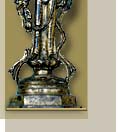Antique bronzes & terra cotta
The Han Dynasty began in 210 BC when Qin Shihuangdi, the Qin Emperor suicided. The chaos which followed this event allowed the Hans’ monopolized the country. The Han Dynasty reined for over 414 years. The Hans kept the frontiers implemented by the Qin’s and these became the modern frontiers of China. The Hans established their capital in Chang’an (actual province of Shaanxi). ). Chang’an was a huge metropolis and also one of the major city of the ancient world (after Roma).
Nevertheless, the Hans aimed to expand their authority. So they undertook military expeditions against the northern barbarians. These expeditions lead them to the Central China’s access. Then the Hans sent some emissaries in Roma and this was the start of the Silk Road, which started in Chang’an and ended in the Mediterranean coasts. The Silk Road enabled thousands of Chinese people sending silk in bulk to the Occident, and that was the first source of a further enrichment of the Hans.
The Hans began to initiate Confucius’concepts in the government board. The Confucian were seen as spiritual leaders as the Hans believed that the power should not be the unique basis of a government. At this time, China experienced a strong scientific growth, for instance the use of paper. But the Hans were famous conquerors too. They intended to unify China. The Emperor Wu’Ti reached that goal as he could push the front line to Viet Nam and Korea.
At the end of Hans’ reign, the Emperor Chang Ti laid down autarkic policies which would prevent from Turkestan’s conquest. On the same occasion, China’s enemies could gather and weaken the Hans. Then internal problems came into sight. A farmers’ rebellion marks the ending of the Hans and the institution of three different kingdoms. |



